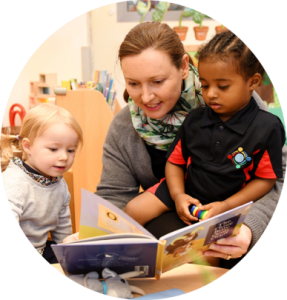
08 Sep BUILDING MY CHILD’S LANGUAGE DEVELOPMENT
HOW LANGUAGE IS DEVELOPED IN YOUNG CHILDREN?
Do you know that infants start recognizing different sounds when they are 6 months of age? They start crying, cooing & babbling to express their needs. They also start showing & pointing during 7 to 15 months of age. They understand gestures and show gestures to communicate. Receptive understanding of language begins to develop. They understand simple instructions e.g. Do you want milk? Keep your shoes. Their expressive language or speech starts to develop as they articulate baby talks and say single words for the first time such as ma-ma, pa-pa, mum-mum, no, etc.
During these vital early years, teach your child their first words, such as father (dada), familiar animal (kitty), vehicles (car), toys (ball), food (milk), body parts (eyes, nose), clothes (pants, shoes). Studies have found that children, who have had vocabulary development during their infancy period (16 to 24 months), show better vocabulary, phonological awareness, reading accuracy and reading comprehension five years later.
WHY SPEECH LANGUAGE IS IMPORTANT?
Language is a form of communication (spoken, written, signed). Language learning has a great influence on children’s cognitive thinking and future development. There are five important language’s rules systems which are phonology, morphonology, syntax, semantics, and pragmatics.
CHILDREN’S VOCABULARY
Children’s vocabulary increase significantly in their early growing years. They begin to understand the tone of voice, gestures, pointing and looking at the direction, music and language spoken around them.
STRATEGIES FOR PARENTS
Use strategies to enhance your child’s acquisition of language:
- Recasting: rephrasing something the child has said that lack appropriate morphology or contain error.
- Expanding: adding information to a child’s incomplete utterance.
- Labelling: naming objects that children seem interested in.
Child-Directed Speech
Language spoken in a higher pitch and slower speed than normal with simple words and sentences can improve children’s native language by heightening differences between speech directed to adults and children. It is important functions of capturing the infant’s attention, maintaining communication and social interaction between caregivers and infants.
Encouragement
Follow the child’s lead, talk about things the child is interested in. Create opportunities for interaction and joint attention. Read storybooks and extend the meaning of the text by discussing it with the child. Encourage them to ask and answer questions. Elaborate information-seeking responses during joint picture-book reading. Read daily to children, label things in the environment. Pay attention to what children is trying to say and expand their utterances.
Biological & Environment
Language Acquisition Device (LAD), according to the Chomsky’s term, describes a biological endowment enables the child to detect features and rules of language. Lack of biological and environmental input may cause Aphasia-brain damage that cause loss or impairment of language ability in Broca’s area, which is responsible for speech production.
The role of Social Interaction
Parents play an important role to facilitate their child’s language development. Infants, who have heard their parents talking, have better speech and language skills. Typical children are naturally and intensely interested in their social world during their growing years.
UNDERSTAND PHONOLOGY & MORPHOLOGYY
Young children increase their grasp of the language rule systems when they become more aware to the sounds of spoken language. You can start teaching your child about prepositions (in, on), articles (a, the), and simple sentences (Daddy is going to work. Say bye-bye!).
CHANGES IN SYNTAX AND SEMANTICS
Young children begin to make an initial connection between a word and its meaning. Therefore, talk to your child often and let them understand the important difference between all words, such as WH-questions, with expressions, variety of tone of voices and gestures. Show interest in whatever you child try to express.
SIX KEY PRINCIPLES IN VOCABULARY BUILDING
1) Children learn the words they hear most often.
2) Children learn words for things that interest them.
3) Children learn words better in responsive & interactive contexts than in passive contexts.
4) Children learn words best in contexts that are meaningful.
5) Children learn words best when they access clear information about the word meaning.
6) Children learn words best when grammar & vocabulary are considered.
PHONICS APPROACH
Parents can provide children the basic rules of translating written symbols into sounds. After they have learned correspondence rules that relate spoken phonemes to the alphabet letters, then only give complex reading materials.


Sorry, the comment form is closed at this time.